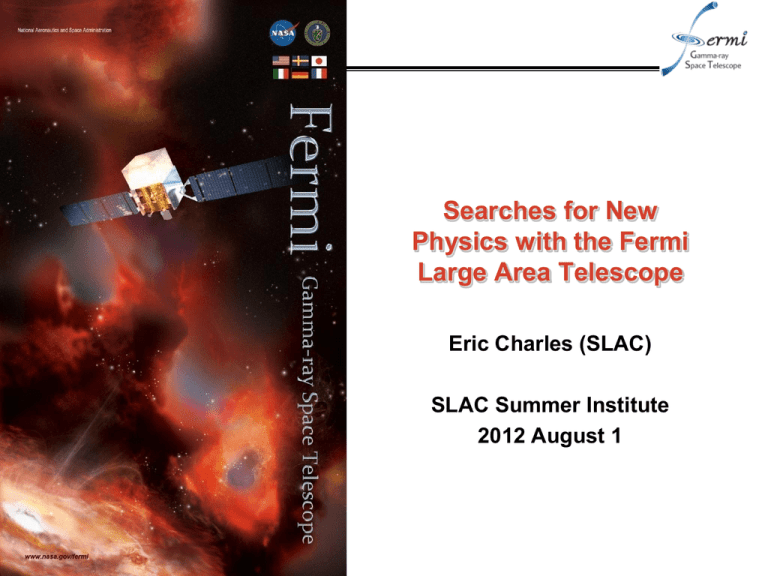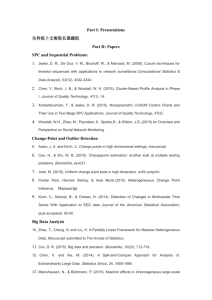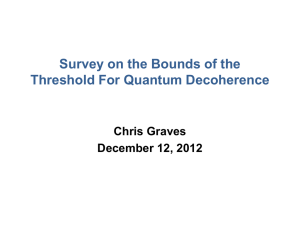SLAC_SummerInst_DMNP_echarles
advertisement

Searches for New Physics with the Fermi Large Area Telescope Eric Charles (SLAC) SLAC Summer Institute 2012 August 1 2 Searches for New Physics with the Fermi-LAT • • • g-ray Astronomy and the Fermi-LAT Indirect Searches for Dark Matter Fermi-LAT Search Strategies and Results Status and Summary 3 Searches for New Physics with the Fermi-LAT • • • g-ray Astronomy and the Fermi-LAT Indirect Searches for Dark Matter Fermi-LAT Search Strategies and Results Status and Summary g-rays Probe the Extreme, Non-Thermal, Universe Dark Nebula Dim, young star Our Sun Globular Cluster Accretion Disk CMB Thermal Processes Extreme Universe Non-thermal g ray emission Energy source Acceleration mechanism Foreground absorption g-ray production mechanism g rays Many Mechanisms Involved in Producing g rays Energy Sources Explosions Accretion Many of these mechanisms will produce radiation at other, non g-ray, wavelengths Rotating Fields Acceleration Mechanisms Reconnection Caustics Other Shocks g-ray Emission Mechanisms p bremsstrahlung synchrotron inverse Compton p0 production One More Potential Mechanism to make g rays Exotic particle rest mass The mechanism is “cleaner” in that it does not require external energy sources, particle acceleration or target material and fields to produce g rays 8 The Fermi Large Area Telescope Public Data Release: All g-ray data made public within 24 hours (usually less) Fermi LAT Collaboration: ~400 Scientific Members, NASA / DOE & International Contributions Si-Strip Tracker: convert g->e+ereconstruct g direction EM v. hadron separation Hodoscopic CsI Calorimeter: measure g energy image EM shower EM v. hadron separation Anti-Coincidence Detector: Charged particle separation Sky Survey: With 2.5 sr Field-of-view LAT sees whole sky every 3 hours Trigger and Filter: Reduce data rate from ~10kHz to 300-500 HZ Synergy with Other Instruments Microwave: diffuse maps Radio: pulsations, synchrotron & morphology, Galaxy emission, ISM maps, characteristics… high resolution imaging of jets AGN host galaxies… LAT Source Localization ~0.1°-0.01° comparable to many field-ofviews LAT: 4+ decades energy band provides lever-arm for spectral fits TeV: High-energy spectral breaks, SNR/ PWN morphology… X-ray: GRB & Flare afterglows, morphology & pulsar association… IR: ISM maps, AGN/GRB host galaxies… Energy Optical: GRB afterglows, AGN/GRB redshits… Wide Variety of Analysis Techniques DM Searches MW Variability & Pulsations Morphology, Source Extension and Counterpart Identification Single Photon Studies Spectra and Spectral Components Catalogs, Population Studies and Luminosity Functions No real “standard” analysis. Many complementary ways to extract information about the g-ray sky 11 Searches for New Physics with the Fermi-LAT • • • g-ray Astronomy and the Fermi-LAT Indirect Searches for Dark Matter Fermi-LAT Search Strategies and Results Status and Summary 12 Evidence for / Salient Features of Dark Matter Comprises majority of mass in Galaxies Coma Cluster + Virial Theorem Zwicky (1937) Almost collisionless Bullet Cluster Clowe+(2006) Large halos around Galaxies Rotation Curves Rubin+(1980) Non-Baryonic CMB Acoustic Oscillations WMAP(2010) 13 Particle Physics offers Dark Matter Candidates Weakly Interacting Massive Particles (WIMPs) are an interesting DM candidate “WIMP Miracle”, WIMPs as thermal relic: Mass scale ~ 100 GeV <sv> ~ 3 10-26 cm3 s-1 14 Dark Matter Searches 15 Dark Matter Searches 16 Indirect Searches for DM in the GeV Sky ??? GeV Sky Galactic Point Sources Isotropic 17 Indirect Searches for DM in the GeV Sky ??? GeV Sky Galactic Point Sources Isotropic Dark Matter Signatures in g-ray Sky Bertone (2007) Particle Physics Astrophysics (J-Factor) 18 19 Searches for New Physics with the Fermi-LAT • • • g-ray Astronomy and the Fermi-LAT Indirect Searches for Dark Matter Fermi-LAT Search Strategies and Results Status and Summary 20 Searches for DM in Cosmic Rays •WIMP Interactions can produce charged cosmic-ray particles •Although charged particles carry little or no directional information, we can look for signs of DM in cosmic-ray spectra 21 Positron Fraction Measurements 2012PhRvL.108a1103A [arXiv:1109.0521] •PAMELA and Fermi-LAT observe a rise in local e+ fraction above ~10 GeV •This disagrees with conventional models (e.g., GALPROP) for cosmic rays (secondary e+ production only) •No similar rise is seen in anti-proton fraction 22 e+e- Combined Spectrum 2009PhRvL.102r1101A [arXiv:0905.0025] 2010PhRvD..82i2004A [arXiv1008.3999] •Fermi-LAT also observes a small, wide, spectral feature in the combined e+e- spectrum between 100GeV and 1 TeV 23 New Fundamental Physics or New Astrophysics? Understanding g-ray sources is key to disentangling fundamental physics from astrophysics Increases discovery potential and allows more stringent constraints on DM 2009APh....32..140G [arXiv:0905.0636] Leptophilic Dark Matter Pulsars 24 e+ + e- Anisotropy 2010PhRvD..82i2003A [arXiv:1008.5119] •Search for large scale anisotropies in e+e- data yield null results •However, the upper-limits are not stringent enough to rule out nearby pulsars as source for high energy leptons 25 Indirect Searches for DM in the g-ray Sky ??? GeV Sky Galactic Point Sources Isotropic 26 Dark Matter Search Strategies Galactic Center Satellites Low background and good Good Statistics, but source source id, but low statistics confusion/diffuse background Spectral Lines Large statistics, but diffuse background Isotropic” contributions Little or no astrophysical uncertainties, good source id, but low sensitivity because of expected small branching ratio Milky Way Halo Galaxy Clusters Low background, but low statistics Large statistics, but astrophysics, galactic diffuse background Dark Matter simulation: Pieri+(2009) arXiv:0908.0195 Search Strategies (against the g-ray Sky) Galactic Center Satellites Low background and good Good Statistics, but source source id, but low statistics confusion/diffuse background Spectral Lines Milky Way Halo Large statistics, but diffuse background Isotropic” contributions Little or no astrophysical uncertainties, good source id, but low sensitivity because of expected small branching ratio 27 Galaxy Clusters Low background, but low statistics Large statistics, but astrophysics, galactic diffuse background 3 Years Sky > 1 GeV 28 Searches for DM Satellites in Unid. LAT Sources Simulated DM Satellite Kazantzidis (2007) 2012ApJ...747..121A,[arXiv:1201.2691] •Look for LAT Catalog Sources that are consistent with DM signatures and inconsistent with known astrophysical sources classes 29 DM in Unid. Sources: Results and Developments • • Search criteria: • Catalog Sources • Off-plane: |b| > 10° • No counterpart at other wavelengths • Steady emission • Spatially extended • Spectrum consistent with DM Results: • No sources pass criteria • From N-body simulations we infer constrains on annihilation cross-section: VL2 subhalos low-mass subhalos (extrapolated) Larger DM Flux than Draco See also: Buckley & Hooper, PRD 82 (2010) 063501; Belikov+ [arXiv:1111.2613]; Zechlin+ [arXiv:1111.3514]; Mirabel+ [arXiv:1205.4825] use Random Forest Classifier to identify DM-like sources in 2FGL Catalog 2012ApJ...747..121A,[arXiv:1201.2691] 30 Searches for DM in Dwarf Spheroidal Galaxies Segue 1 Keck Observatory 2010ApJ...712..147A [arXiv:1001.4531] 2011PhRvL.107x1302A [arXiv:1108.3546] 2012JCAP...04..016C [arXiv:1111.2604] arXiv:1205.3620aarXiv:1203.6731 •Look for g-ray emission from Dwarf Spheroidal galaxies with large, well measured, J-factors at high Galactic latitudes •This is as a low-signal, low-background search strategy 31 DM in dSph: Search Targets •Roughly two dozen Dwarf Spheroidal satellite galaxies of the Milky Way •Some of the most dark matter dominated objects in the Universe •Negligable astrophysical g-ray production expected 32 DM in dSph: Results Combined upper limit excludes “canonical” thermal relic cross-section for annihilation into bb or t+t- for masses below ~ 30GeV 2011PhRvL.107x1302A [arXiv 1108.3546] 33 DM in dSph: Prospects Discovery of new dSph and increased observing time should allow us to explore the thermal relic cross section up to almost 1TeV by the end of the mission Coma Cluster Spitzer/ SDSS/ JPL/ NASA Search for DM in Galaxy Clusters 2010JCAP...05..025A [arXiv:1002.2239] •Look for g-ray emission from Galaxy Clusters with high missing mass and no g-ray blazars (or other AGN) •This is a low-signal, potentially low-background search strategy 35 DM in Galaxy Clusters: Search Strategy Stacked Cluster Counts Map • Clusters are largest and most massive structures in universe • Lensing / X-ray data imply high DM content • High DM signal • Radio data implies relativistic CR • Potential g-ray backgrounds • Results: • No significant detection • Infer limits from individual clusters and for the stacked sample 2010JCAP...05..025A [arXiv:1002.2239] 36 Limits from Galaxy Clusters •Combined cluster limits are less stringent than dSph •However, there is significantly more uncertainty about DM distributions •Galaxy Clusters can be competitive with dSph for constraining models with enhanced DM rates 2010JCAP...05..025A [arXiv:1002.2239] 37 Search for DM in the Galactic Halo Simulation of 250 GeV WIMP into b bbar arXiv:1205.6474v1 •Look for a hard-spectral excess near (but slightly off) the Galactic plane •This is a trade-off between larger signals in the plane and smaller astrophysical foregrounds away from the plane Halo Method I: “No-background” Limits • No non-DM background modeling • Robust to many uncertainties (models leave many structured residuals in ROI) Preliminary • Expected DM counts (nDM) compared to observed counts (ndata) • 3s and 5s upper limits are set using • in at least one energy bin arXiv:1205.6474v1 38 Halo Method II: “Marginalize over Diffuse Models” •Template-based profile likelihood fit: •Diffuse components, some GALPROPbased •Isotropic component •DM component •Sample ranges of several key bkg. parameters: •CRE injection index •diffuse halo height •gas (HI) to dust ratio •CR source distribution •local H2 to CO factor •isotropic normalization Preliminary arXiv:1205.6474v1 39 40 Halo Search Results: bb Channel •Method II (marginalize over astrophysical models) limits are about an order of magnitude deeper than conservative limits •Similar to saying that we understand about 90% of the diffuse emission in the Galactic Halo region arXiv:1205.6474v1 Halo Search Results: m+m- Channel 41 •blue: only g rays produced by m+m- (no e+e-) to set “no-background limits”, i.e., only including Final State Radiation (FSR) •violet: “no-background limits” including FSR + Inverse Compton (IC) from DM •black: limits from profile likelihood + CR sources set to zero in the inner 3 kpc DM interpretation of PAMELA/Fermi CR anomalies in tension with limits derived by including background modeling arXiv:1205.6474v1 42 Search for DM in the Inner Galaxy •The eventual goal is to look for DM in the inner Galaxy •Because of the large astrophysical foregrounds, we must first understand the g-ray emission from the Galaxy and from known source classes 43 IG Analysis: Refitting the Diffuse Model ??? Galactic Inverse Compton Point Sources Bremsstrahlung Isotropic p0 decay •Start with diffuse emission model which is tuned to the inner 45°x45° of the Galaxy •Analysis in progress, stay tuned Search for g-ray Line(s) 44 2010PhRvL.104i1302A [arXiv:1108.0501] arXiv:1205.2739 •Look for spectral features consistent with the instrumental energy resolution •A very clean signal, but highly suppressed in many WIMP scenarios 45 Search for g-ray Line(s): Data Analysis arXiv:1205.2739 •Search for g-ray line for DM annhilation or decay (gg and gZ channels) •Data Analysis: •Exclude Galactic plane and mask 1FGL catalog sources •Fit in sliding windows to powerlaw background (index free) + energy resolution PDF •Extract limits for Einasto, NFW and Isothermal DM profiles 46 Line Search Upper Limits arXiv:1205.2739 •Non-detection used to place limits on annihilation cross section for 3 DM profiles 47 Reprise: New Physics or New Astrophysics Interpretations and follow up analyses: Bringmann+ [arXiv:1203.1312] Weniger [arXiv:12.2797] Tempel+ [arXiv:1205.1045] Kyae & Park [arXiv:1205.4151] Dudas+ [arXiv:1205.1520] Lee+ [arXiv:1205.4700] Acharya+ [arXiv:1205.5789] Buckley & Hooper [arXiv:1205.6811] Su & Finkbeiner [arXiv:1206.1616] Chu,Hambye + [arXiv:1206.2279] & many others Astrophysical Interpretations: Narrow excess ~130GeV associated with Inner Galaxy Many DM models, but also models of spectra features from astrophysics Need to extract more information from morphology and MW observations Boyarsky+ [arXiv:1205.4700] Aharonian+ [arXiv: 1207.0458] 48 DM Limits from Inclusive Spectrum 2010PhRvL.104i1302A [arXiv:1108.0501] arXiv:1205.2739 •Limit DM to avoid saturating the observed spectrum in the line search ROI •Very conservative limits, no model subtraction 49 Inclusive Spectrum Limits arXiv:1205.2739 •Similar to Halo analysis “Method I”, simply ask how much DM signal we can have without saturating the observed spectrum in the line-search ROI •20°x20° at Galactic Center + |b| > 10° The limits from the t+t- channel in particular are at odds with DM interpretations of features in the e+e- spectrum and the rise in the positron fraction DM Contributions to the “Isotropic” Background 50 2010PhRvL.104j1101A [arXiv:1002.3603] 2010JCAP...04..014A [arXiv:1002.4415] 2012PhRvD..85h3007A [arXiv:1202.2856] 2011MNRAS.414.2040C [arXiv:1005.0843] •Look for signatures of Dark Matter in the Isotropic background •This requires good knowledge of all the astrophysical foregrounds Summing Contributions to the g-ray Sky 51 IGRB Spectrum: Abdo+ (LAT) [arXiv:1002.3603] BL Lac (LAT Preliminary) Sum of Components SFGs:, Ackemann+ (LAT) [arXiv:1206.1346] FSRQs: Ajello+ (LAT) [arXiv:1110.1387] Radio Galaxies: Inoue [arXiv:1103.3946] By estimating and modeling the contributions of unresolved sources in known source classes to the IGRB, we can constrain the potential contribution for unknown source classes (such as DM) See other studies by: Stecker&Salomon+96, Pavlidou&Fields+02, Narumoto&Totani06,Dermer07, Bhattacharya+09, Inoue&Totani09, Fields+10, Makiya+10, Inoue+11,Abazajian+10, Ghirlanda+11,Stecker&Venters11,Malyshev&Hogg11 IGRB > 100GeV (LAT Preliminary) Constraining DM with g-ray Anisotropies •Measure the angular power spectrum of large-scale isotropic g-ray bkg. •Significant (3s) detection of angular power from 1-10 GeV •Fluctuation angular power is consistent with constant from 150GeV •Constrains fractional contribution of individual sources classes (including DM) 52 Fornasa+(2012) [arXiv:1207.0502] See also: Ando+ (2007), Miniati+ (2007), Siegal-Gaskins (2008), Cuoco+ (2008), Fornasa+(2009), Zavala+(2010) , Cuoco+(2011), Campbell & Dutta (2011) 53 Other Searches for DM and New Physics Limits on Lorentz Invariance Violation from arrival times of high energy g rays in GRB 090510 Limits on Large Extra Dimensions from non-detection of g rays from Neutron Stars 2009Natur.462..331A [arXiv:0908.1832] 2012JCAP...02..012F [arXiv:1201.2460] Cosmic-ray electrons from the Sun 2011PhRvD..84c2007A [arXiv:1107.4272] Searches for Axions from Galaxy Clusters (E.g., Sanchez-Conde+ 2009 arXiv:0905.3270) STATUS AND SUMMARY 55 Summary and Status • The Fermi-LAT collaboration has searched for DM in a wide variety of ways • We have not observed any DM signals to date • We have placed constraints on many DM scenarios • Fermi-LAT e+e- data disagree with conventional models • Explanation may or may not involve DM • The search for DM in dSphs has excluded the canonical thermal relic annihilation cross section below ~30 GeV • With 10 years data and more dSphs we expect to be able to search for signals from WIMP with masses up to 1 TeV • DM search in the Galactic halo also puts strong constraints on thermal relic WIMPs below ~30 GeV • Analysis depends on knowledge of diffuse emission




